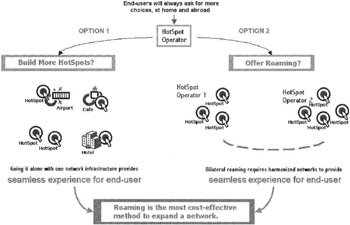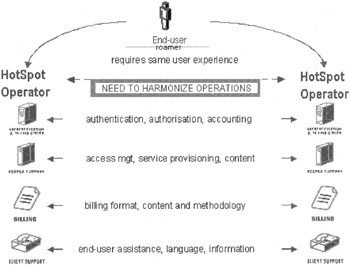Roaming Agreements
|
| < Day Day Up > |
|
Roaming will play a significant role in the development (or nondevelopment) of a nationwide network of HotSpots, providing end-users with seamless access in diverse geographical locations.
For the WISP industry the term "roaming" refers to the agreement between two or more HotSpot operators whereby every signee's subscribers can access the other signees' networks. (Whereas the ability to seamlessly travel from one coverage zone to another within the same HotSpot operator's network without losing the session is called a "handover.") Roaming agreements are the answer to the "islands of connectivity" syndrome that dogs the average HotSpot operator. The typical roaming agreement regulates and stipulates the technical and commercial conditions of such access and is a pre-requisite to initiating roaming services.
Phil Belanger, a Pass-One spokesperson says that, based on lessons learned from the cellular industry, enabling roaming between different HotSpot operators is a key prerequisite for the success of the WISP industry. "The classic model for distributing income is the cellular world, in particular GSM. In Europe, GSM is very successful in getting roaming across what used to be very separate domains."
To prosper, the HotSpot industry, as a whole, needs unified roaming since it is the best way for end-users to avoid the hassle of needing to sign up for multiple accounts in order to obtain ubiquitous connectivity. Roaming also means more opportunities for recurring revenue throughout the WISP industry.

Figure 11.10: This shows the choices available to HotSpot operators who want to provide their end-users with an ever-wider coverage area, but are unwilling to go through an aggregator. Both options require the operator to build and maintain extensive back-office systems. But perhaps the bilateral roaming model presents the most challenges. Roaming end-users demand the same user experience no matter which network they are using. To provide such uniform experience, however, requires that the roaming partners harmonize their operations, e.g. AAA, assess management, service provisioning, content, billing, and end-user assistance.
At the moment, HotSpot operators have a number of choices when it comes to expanding their area of coverage in an effort to provide network subscribers the unlimited coverage they demand: go it alone (similar to what T-Mobile is doing); grow their network via individual bilateral roaming agreements (this is how many currently operators provision roaming capability); partner with one or more aggregators and hand the roaming details over to them; or join Pass-One's roaming initiative.
HotSpot subscribers look for places to access the Internet, whether they are within their home network's territory or not. That's what roaming between non-related HotSpots (such as between WayPort's HotSpots and Cafe.com's HotSpots) provides. For the HotSpot operator, roaming offers the possibility to expand its footprint without investing in additional infrastructure.
| Note | A "bilateral roaming agreement" is a roaming agreement signed between two service providers directly, whereas a "multilateral roaming agreement" is a roaming agreement signed between a HotSpot operator and a central legal entity representing a community of member HotSpots, such as an aggregator or Pass-One. Such an agreement allows for flexible tariffs with certain roaming partners, while the entire administration is centralized. |
Going it alone requires a huge bankroll. For the HotSpot operator with a vision of a nationwide chain of HotSpots, the network needs to have a robust back-office system and a diverse workforce. The necessary team includes a sales force to sign-up venues, staff to design and maintain a website, a skilled technical staff to manage and maintain the network, and a visionary executive group. A high-profile marketing campaign is also needed to drive traffic to the new HotSpots. Systems to support the growing HotSpot network will also be needed—AAA, asset management, service provisioning, content, billing (format content and methodology), customer support, and end-user assistance.
If a HotSpot operator brings bilateral roaming into the mix, however, the staff can concentrate on its strengths such as providing HotSpot capabilities to the hospitality industry (e.g. RoomLinX) or to travel venues (e.g. Wayport). By entering into bilateral roaming agreements, HotSpot operators allow authorized outside non-customers to use their network. However, this scenario requires HotSpot operators to take on different roles—a HotSpot operator is both a home network for its own customers and a visited network for the roaming customers of another network, i.e. they offer service to their own end-users as well as external end-users.
The home operator assures the payment of usage by its own customers, and guarantees the income from inbound roaming to the visited HotSpot operator. This reduces financial risks. Thus, a HotSpot operator offers its network capacity to incoming users because payment is pledged by a "guaranteed payer." Sound complicated? It is. This model requires the roaming agreement signatories not only to put in place extensive back-end systems, but also the roaming partners must harmonize their operations in order to provide their subscribers with a seamless roaming experience.
NetNearU, a provider of management and billing systems for HotSpot systems, has set up roaming agreements with several prominent HotSpot operators. According to Cody W. Catalena, the provider's executive vice president, "Operators that deploy a NetNearU system can provide seamless roaming for their user bases and others to roam into that network, and receive the roaming revenues. The revenue model is signing up your own user base, and then being able to accept users for other networks on your network and get a fair share of the revenue. Roaming will follow the same model as the cellular market, where first you were charged for roaming, but now can get the same rate for roaming in a national plan."

Figure 11.11: The challenges to offering bilateral roaming—harmonization of operations is essential to providing end-users with a successful roaming experience.
Another option is virtual roaming. This model requires an aggregator and multilateral roaming agreements. Most in the industry feel that for a national network of HotSpots to become a reality, virtual roaming must become the norm. And although aggregators are crafting partnerships with various HotSpot operators, especially in North America, there is still much to do before national and international roaming is a fact of life.
When a HotSpot operator becomes a partner to a multilateral roaming agreement, that operator turns most of the headaches (e.g. record keeping and housekeeping) over to the aggregator. No wonder many operators feel that entering into multilateral roaming agreements is the best way to offer their end-users more value. By signing such agreements, a HotSpot operator can offer a magnitude of HotSpot accessibility outside its own network without becoming burdened with more back-office chores. The financial advantage also is compelling since the payment flow is focused on the roaming partners and the inter-operator wholesale charge typically includes a mark-up fee.
Thus, both the bilateral and multilateral roaming models enable a HotSpot operator to reduce the need for additional investment in network infrastructure while optimizing the capacity of its existing HotSpots. Both also have the potential of increasing the operator's overall revenue stream.
There's one more model to investigate—Pass-One's approach to universal roaming. In September 2002, Pass-One members decided to open their networks to each other's end-users. To facilitate such roaming capability, the organization agreed upon an "inter-WISP roaming framework" that sets the roaming policies applicable to new members (e.g. the charging principles—wholesale and retail tariff, charging reference per time and timeslot, roaming relationships, invoicing and settlement rules, and a guaranteed minimum set of service levels that will warrant a global end-user experience). The result is that end-users of, for example, Wayport (U.S.), FatPort (Canada), Open Point Networks (U.S.), Wificom (France), and Tele2 (Sweden) are allowed to use the combined network of all HotSpots operated by each member.
There is also Wi-Fi Alliance's WISPr approach. While WISPr doesn't offer a roaming model, per se, it does create recommendations that facilitate inter-network and inter-operator roaming with Wi-Fi-based access equipment. WISPr's charter is to "describe the recommended operational practices, technical architecture, and Authentication, Authorization, and Accounting (AAA) framework needed to enable subscriber roaming among Wi-Fi-based Wireless Internet Service Providers (WISPs)." The resulting roaming framework is designed to allow end-users with Wi-Fi compliant devices to roam into Wi-Fi-enabled HotSpots for public access and services. Users can be authenticated and billed (if appropriate) for service by their home network provider.
That framework is laid out in a WISPr document released in February 2003, entitled "Best Current Practices for Wireless Internet Service Provider (WISP) Roaming." It is available for downloaded at www.wi-fi.org/opensection/downloads/wispr_v1.0.pdf. The document, in short, recommends that the WISP industry adopt a browser-based Universal Access Method (UAM) for the public to access the Internet via Wi-Fi technology. The UAM allows a subscriber to access a HotSpot's network with only a Wi-Fi network interface and Internet browser on the end-user's device. It also recommends that RADIUS (Remote Authentication Dial In User Service) be the back-end AAA protocol that supports the access, authentication, and accounting requirements of WISP roaming. To that end, the document describes a minimum set of RADIUS attributes needed to support basic services, fault isolation, and session/transaction accounting.
Another organization taking a stab at addressing roaming issues is the Asia-based Wireless Broadband Alliance. It adopts a holistic approach by establishing three working groups to address the legal and administrative framework for roaming agreements, the development of a uniform technical approach, and the cross-promotion of HotSpot related services via a single international brand. Its inter-operator roaming platform is expected to be operational by June 2003 and the Alliance says that it is in discussions with other international telcos with regard to expanding its coverage worldwide. It is thought that the Wireless Broadband Alliance will seek to leverage existing telco roaming and clearinghouse facilities.
|
| < Day Day Up > |
|
EAN: 2147483647
Pages: 273